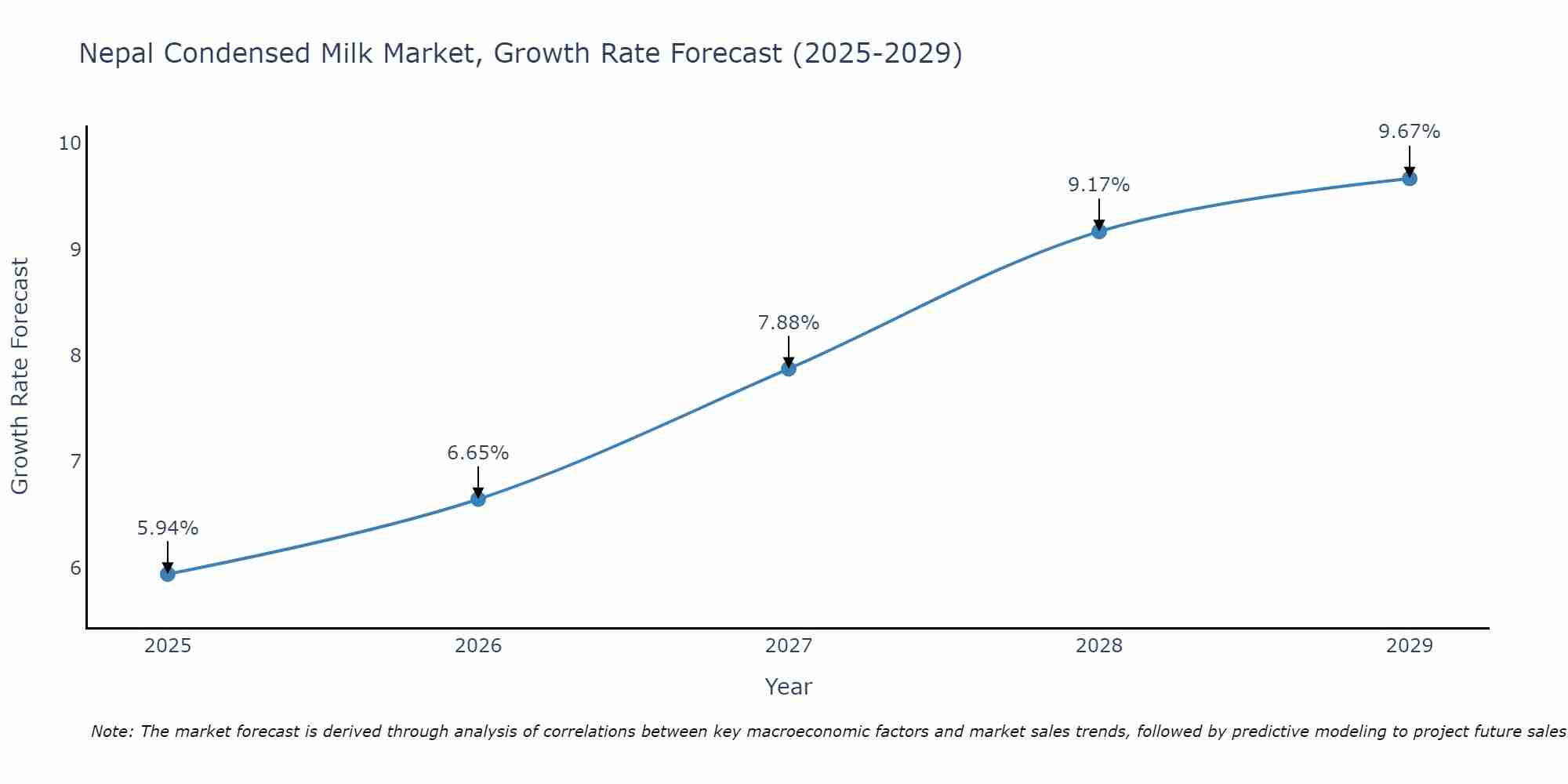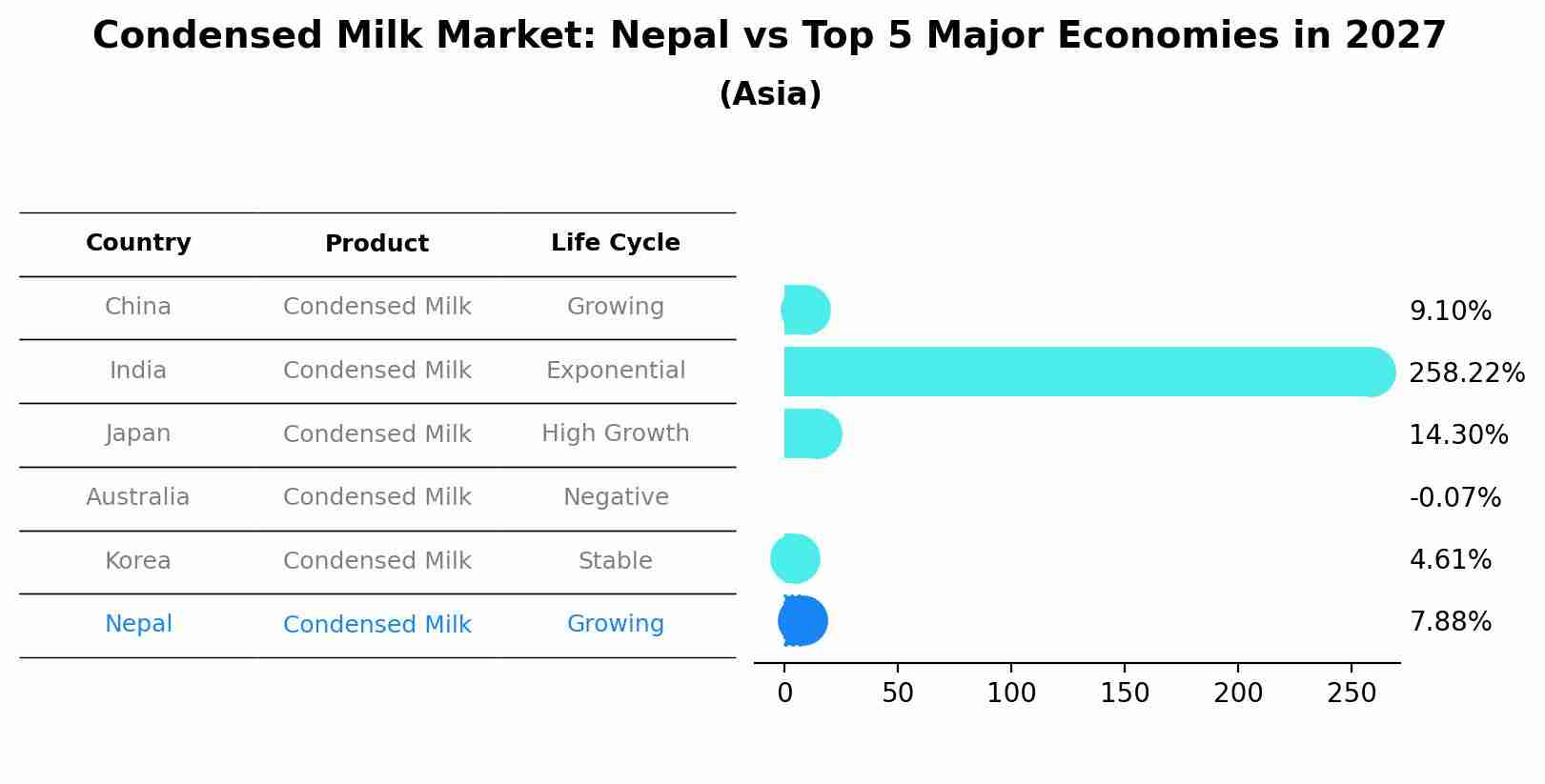Nepal Condensed Milk Market (2025-2031) Outlook | Share, Revenue, Forecast, Trends, Companies, Growth, Analysis, Industry, Size & Value
| Product Code: ETC381096 | Publication Date: Aug 2022 | Updated Date: Jul 2025 | Product Type: Market Research Report | |
| Publisher: 6Wresearch | Author: Sumit Sagar | No. of Pages: 75 | No. of Figures: 35 | No. of Tables: 20 |
Nepal Condensed Milk Market Size Growth Rate
The Nepal Condensed Milk Market is poised for steady growth rate improvements from 2025 to 2029. From 5.94% in 2025, the growth rate steadily ascends to 9.67% in 2029.

Condensed Milk Market: Nepal vs Top 5 Major Economies in 2027 (Asia)
The Condensed Milk market in Nepal is projected to grow at a growing growth rate of 7.88% by 2027, within the Asia region led by China, along with other countries like India, Japan, Australia and South Korea, collectively shaping a dynamic and evolving market environment driven by innovation and increasing adoption of emerging technologies.

Nepal Condensed Milk Market Synopsis
The Nepal condensed milk market has been experiencing steady growth due to the increasing popularity of condensed milk as a versatile ingredient in various traditional Nepali desserts and beverages. The market is primarily dominated by key players offering a wide range of condensed milk products catering to the diverse consumer preferences. Factors such as changing consumer lifestyles, rising disposable incomes, and expanding distribution channels have further fueled the market growth. Additionally, the growing demand for convenient and ready-to-use dairy products has also contributed to the market expansion. With a focus on product innovation, quality, and affordability, the Nepal condensed milk market is expected to continue its growth trajectory in the coming years, presenting opportunities for both domestic and international dairy companies to capitalize on the market potential.
Nepal Condensed Milk Market Trends
In the Nepal condensed milk market, there is a growing demand for healthier and organic options as consumers become more health-conscious and seek premium products. Manufacturers are responding to this trend by introducing organic condensed milk products and promoting them as a healthier alternative. Convenience and product variety are also key trends, with companies offering condensed milk in different packaging formats such as squeeze bottles or resealable pouches to cater to different consumer needs. Additionally, there is a rising interest in flavored condensed milk varieties, including options like chocolate, vanilla, and coffee flavors, to appeal to a wider audience and enhance the overall consumer experience. Overall, the market is witnessing a shift towards more premium, healthier, and convenient condensed milk products to meet evolving consumer preferences.
Nepal Condensed Milk Market Challenges
In the Nepal condensed milk market, several challenges are faced, including intense competition from both domestic and international brands, fluctuating raw material prices, limited distribution channels in rural areas, and varying consumer preferences. The market is also impacted by counterfeit products, which affect consumer trust and brand reputation. Additionally, regulatory challenges and quality control issues pose obstacles for manufacturers in ensuring product safety and compliance with standards. Furthermore, economic instability and changing consumer spending patterns can impact overall demand for condensed milk products in the market. Overcoming these challenges will require innovative marketing strategies, investment in distribution networks, quality assurance measures, and a deep understanding of consumer needs and preferences.
Nepal Condensed Milk Market Investment Opportunities
The Nepal condensed milk market presents promising investment opportunities due to the country`s growing dairy industry and increasing consumer demand for convenient, shelf-stable dairy products. With a rising middle-class population and changing consumer preferences towards premium and healthy food options, there is a potential market for high-quality condensed milk products. Investors can consider opportunities to collaborate with local dairy farmers for a stable milk supply chain, invest in modern processing facilities to ensure product quality and safety, and strategically market the products to target various consumer segments. Additionally, exploring innovative packaging solutions and expanding distribution channels to reach urban and rural areas can help capitalize on the growing market demand for condensed milk in Nepal.
Jordan Agar Market Government Policies
In Nepal, the condensed milk market is regulated by the Food Act, which sets standards for the production, labeling, and sale of condensed milk products to ensure consumer safety and quality. The Department of Food Technology and Quality Control (DFTQC) is responsible for monitoring and enforcing these regulations to prevent adulteration and ensure compliance with food safety standards. Additionally, the government imposes import tariffs and taxes on condensed milk products to protect domestic producers and promote self-sufficiency in the dairy industry. These policies aim to maintain the integrity of the condensed milk market in Nepal by promoting fair competition, consumer protection, and sustainable growth in the dairy sector.
Nepal Condensed Milk Market Future Outlook
The future outlook for the Nepal Condensed Milk Market appears promising, driven by factors such as increasing consumer preference for convenience foods, rising disposable incomes, and a growing trend towards home baking and cooking. The market is expected to witness steady growth as condensed milk continues to be a popular ingredient in traditional Nepali sweets and desserts. Moreover, the expanding retail sector and the availability of a wide range of condensed milk products are likely to further fuel market growth. Manufacturers in the sector are focusing on product innovation, packaging enhancements, and marketing strategies to attract consumers. Overall, with favorable market dynamics and changing consumer preferences, the Nepal Condensed Milk Market is anticipated to experience sustained growth in the coming years.
Key Highlights of the Report:
- Nepal Condensed Milk Market Outlook
- Market Size of Nepal Condensed Milk Market, 2024
- Forecast of Nepal Condensed Milk Market, 2031
- Historical Data and Forecast of Nepal Condensed Milk Revenues & Volume for the Period 2021 - 2031
- Nepal Condensed Milk Market Trend Evolution
- Nepal Condensed Milk Market Drivers and Challenges
- Nepal Condensed Milk Price Trends
- Nepal Condensed Milk Porter's Five Forces
- Nepal Condensed Milk Industry Life Cycle
- Historical Data and Forecast of Nepal Condensed Milk Market Revenues & Volume By Product Type for the Period 2021 - 2031
- Historical Data and Forecast of Nepal Condensed Milk Market Revenues & Volume By Dairy for the Period 2021 - 2031
- Historical Data and Forecast of Nepal Condensed Milk Market Revenues & Volume By Non-Dairy for the Period 2021 - 2031
- Historical Data and Forecast of Nepal Condensed Milk Market Revenues & Volume By Packaging Type for the Period 2021 - 2031
- Historical Data and Forecast of Nepal Condensed Milk Market Revenues & Volume By Cans for the Period 2021 - 2031
- Historical Data and Forecast of Nepal Condensed Milk Market Revenues & Volume By Tubes for the Period 2021 - 2031
- Historical Data and Forecast of Nepal Condensed Milk Market Revenues & Volume By Bottles for the Period 2021 - 2031
- Historical Data and Forecast of Nepal Condensed Milk Market Revenues & Volume By Distribution Channel for the Period 2021 - 2031
- Historical Data and Forecast of Nepal Condensed Milk Market Revenues & Volume By Supermarkets and Hypermarkets for the Period 2021 - 2031
- Historical Data and Forecast of Nepal Condensed Milk Market Revenues & Volume By Convenience Stores for the Period 2021 - 2031
- Historical Data and Forecast of Nepal Condensed Milk Market Revenues & Volume By Specialty Stores for the Period 2021 - 2031
- Historical Data and Forecast of Nepal Condensed Milk Market Revenues & Volume By Online Retails for the Period 2021 - 2031
- Historical Data and Forecast of Nepal Condensed Milk Market Revenues & Volume By Others for the Period 2021 - 2031
- Nepal Condensed Milk Import Export Trade Statistics
- Market Opportunity Assessment By Product Type
- Market Opportunity Assessment By Packaging Type
- Market Opportunity Assessment By Distribution Channel
- Nepal Condensed Milk Top Companies Market Share
- Nepal Condensed Milk Competitive Benchmarking By Technical and Operational Parameters
- Nepal Condensed Milk Company Profiles
- Nepal Condensed Milk Key Strategic Recommendations
Frequently Asked Questions About the Market Study (FAQs):
- Single User License$ 1,995
- Department License$ 2,400
- Site License$ 3,120
- Global License$ 3,795
Search
Thought Leadership and Analyst Meet
Our Clients
Related Reports
- Afghanistan Apparel Market (2026-2032) | Growth, Outlook, Industry, Segmentation, Forecast, Size, Companies, Trends, Value, Share, Analysis & Revenue
- Canada Oil and Gas Market (2026-2032) | Share, Segmentation, Value, Industry, Trends, Forecast, Analysis, Size & Revenue, Growth, Competitive Landscape, Outlook, Companies
- Germany Breakfast Food Market (2026-2032) | Industry, Share, Growth, Size, Companies, Value, Analysis, Revenue, Trends, Forecast & Outlook
- Australia Briquette Market (2025-2031) | Growth, Size, Revenue, Forecast, Analysis, Trends, Value, Share, Industry & Companies
- Vietnam System Integrator Market (2025-2031) | Size, Companies, Analysis, Industry, Value, Forecast, Growth, Trends, Revenue & Share
- ASEAN and Thailand Brain Health Supplements Market (2025-2031) | Strategy, Consumer Insights, Analysis, Investment Trends, Opportunities, Growth, Size, Share, Industry, Revenue, Segments, Value, Segmentation, Supply, Forecast, Restraints, Outlook, Competition, Drivers, Trends, Demand, Pricing Analysis, Competitive, Strategic Insights, Companies, Challenges
- ASEAN Bearings Market (2025-2031) | Strategy, Consumer Insights, Analysis, Investment Trends, Opportunities, Growth, Size, Share, Industry, Revenue, Segments, Value, Segmentation, Supply, Forecast, Restraints, Outlook, Competition, Drivers, Trends, Demand, Pricing Analysis, Competitive, Strategic Insights, Companies, Challenges
- Europe Flooring Market (2025-2031) | Outlook, Share, Industry, Trends, Forecast, Companies, Revenue, Size, Analysis, Growth & Value
- Saudi Arabia Manlift Market (2025-2031) | Outlook, Size, Growth, Trends, Companies, Industry, Revenue, Value, Share, Forecast & Analysis
- Uganda Excavator, Crane, and Wheel Loaders Market (2025-2031) | Strategy, Consumer Insights, Analysis, Investment Trends, Opportunities, Growth, Size, Share, Industry, Revenue, Segments, Value, Segmentation, Supply, Forecast, Restraints, Outlook, Competition, Drivers, Trends, Demand, Pricing Analysis, Competitive, Strategic Insights, Companies, Challenges
Industry Events and Analyst Meet
Whitepaper
- Middle East & Africa Commercial Security Market Click here to view more.
- Middle East & Africa Fire Safety Systems & Equipment Market Click here to view more.
- GCC Drone Market Click here to view more.
- Middle East Lighting Fixture Market Click here to view more.
- GCC Physical & Perimeter Security Market Click here to view more.
6WResearch In News
- Doha a strategic location for EV manufacturing hub: IPA Qatar
- Demand for luxury TVs surging in the GCC, says Samsung
- Empowering Growth: The Thriving Journey of Bangladesh’s Cable Industry
- Demand for luxury TVs surging in the GCC, says Samsung
- Video call with a traditional healer? Once unthinkable, it’s now common in South Africa
- Intelligent Buildings To Smooth GCC’s Path To Net Zero


















